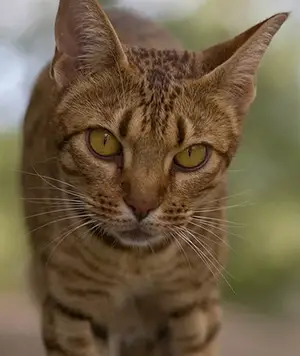Breed Standard
Head: Slightly triangular, as long as it is wide, with rounded contours. The profile exhibits a slight inward curve. Jowls are tolerated in adult males. Well-defined, broad, slightly angular muzzle. Slight whisker pinch. Slight rise from the bridge of the nose to the brow. Strong chin.
Eyes: Large, almond-shaped, set slightly at a slant, separated by more than one eye-width. All colors are allowed except blue and are not related to coat color. Colorpoints have blue eyes (n).Even, intense color is preferred.
Neck: Arched.
Body: Large, fairly long, semi-foreign, powerful, but never massive. Fairly deep chest. Well-developed bone and muscle structure.
Paw: Moderately long, powerful, and muscular. Compact, oval paws.
Tail: Fairly long, moderately slender, tapering slightly to a dark tip.
Coat: Hair is short but long enough to have several bands of color. Fine, smooth, satiny coat with shiny highlights. Spotted and agouti coat (spotted tabby coat). Each hair, except those at the tip of the tail, has several bands of color. The recognized colors are: - brown (or tawny) - chocolate - lilac - blue - cinnamon - fawn These six colors also exist in silver varieties. All colors must be clear and pleasant. The lightest coloration is normally found on the face, chin, and lower jaw. Markings consist of hairs with darker tipping. They should be clear and distinct. They are darker on the face, legs, and tail than on the body. Dark tail tip. Tabby "M" on the forehead. Mascara markings around the eyes and cheeks.
Fault: Massive or stocky body. Blue eyes. Weak and indistinct markings. White spotting or white locket.
History
A spotted athlete with mascara markings around her eyes. "Ocicat" is a combination of the words "ocelot" (a spotted wild cat of the Americas) and "cat". Indeed, this breed has a spotted coat that makes it resemble a small wild cat. In 1964, Virginia Daly, a breeder in Berkeley, Michigan, crossed a Siamese-Abyssinian mix with a chocolate point Siamese in an effort to obtain tabby point Siamese cats. A male in the litter named Tonga and wearing an ivory coat with gold spots was unfortunately neutered. Daly continued her work while other breeders, including Tom Brown, crossed Abyssinians, Siamese, spotted Oriental Shorthairs, Egyptian Maus, and American Shorthairs in order to obtain the Ocicat's current morphology. The breed was officially recognized by the C.F.A. in 1986, and T.I.C.A. published a standard in 1988. Outcrosses with Abyssinians are now forbidden. In 1989, the first Ocicats were sent to France. Though popular in the United States, the Ocicat is still very rare in Europe.
Behavior
The Ocicat is very lively, highly active, curious, and playful. Despite his similarity to a small wild cat, he is very friendly, gentle, and affectionate. In fact, he will not tolerate solitude. Ocicats are loyal and exclusive like the Siamese, but they have a softer voice. They are very accepting of children but fairly dominant toward other cats. They adapt easily to new living conditions. They are easy to groom, as they simply require regular brushing.
Health
The issue is whether or not PRA (Progressive Renal Atrophy) is a genetic disorder in Ocicats. Abyssinians as a breed have been issued a health program by SVERAK in order to limit this genetic defect. Since the ocicats are descendants of Abys, there is a fear that PRA might also be a risk for the Ocicat.






